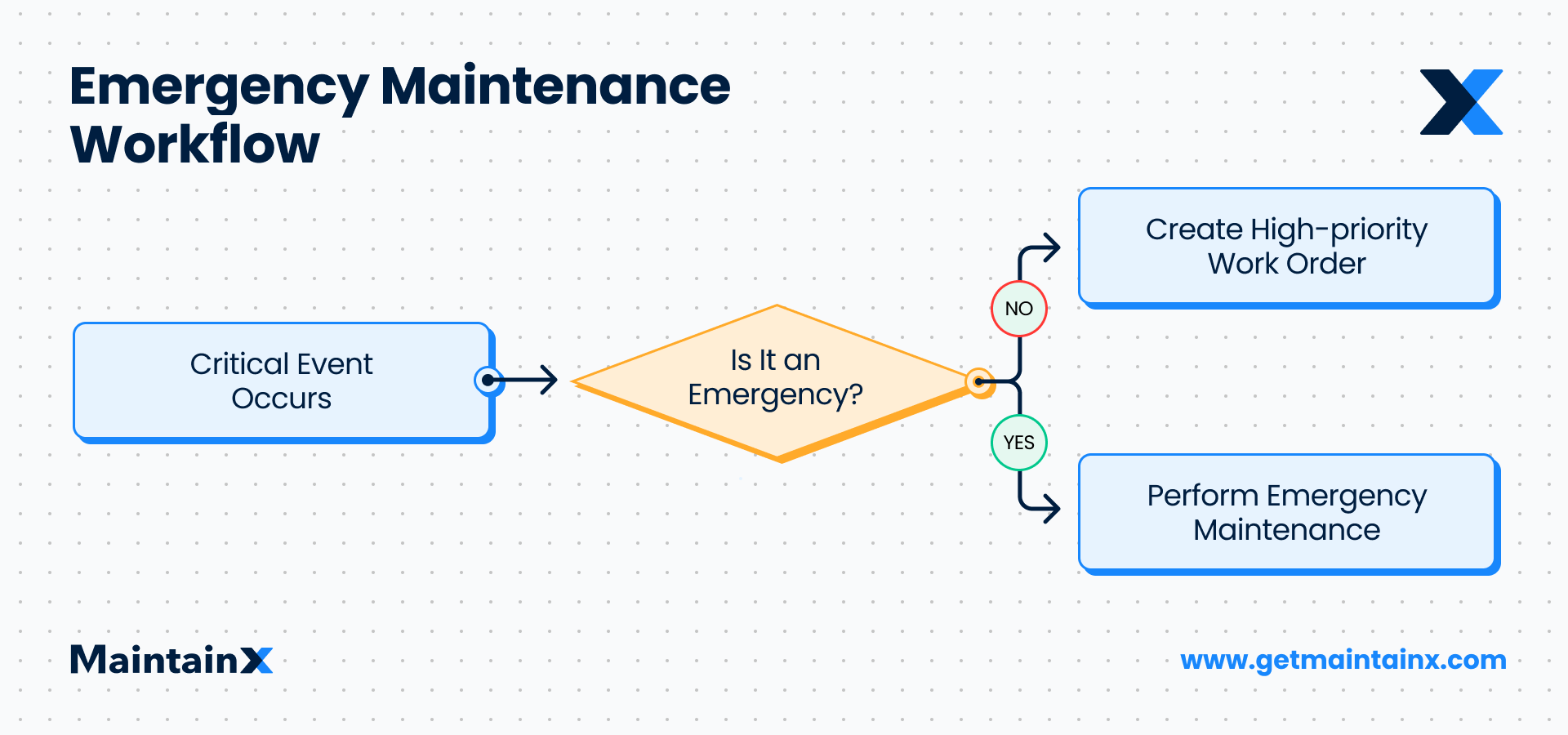Picture this: It's 3 a.m., and you're the only emergency maintenance technician on duty at your manufacturing facility.
The phone rings. It's the control room operator calling to tell you that the main production line conveyor has stopped.
"Is anyone in danger?" you ask.
"No, we have cleared and locked out the line," he says. This scenario shows a critical distinction in maintenance management. Emergency maintenance happens when equipment breaks down and creates an immediate safety threat or serious property damage risk. Understanding when maintenance truly qualifies as an emergency saves your organization significant costs while ensuring your team follows proper safety protocols.
Key takeaways
- Emergency maintenance addresses immediate threats to safety, property, or critical operations, requiring an instant response.
- Distinguishing between emergency and urgent tasks is key to controlling costs and allocating resources effectively.
- A strong preventive maintenance program is the most effective way to reduce the frequency and severity of emergency events.
- An emergency maintenance plan should clearly define response protocols, safety procedures, and risk assessment steps for your team.
What is emergency maintenance?
Emergency maintenance (EM) is any maintenance action undertaken to address and correct a threat to the lives, property, profitability, or viability of an organization. For example, in manufacturing facilities, emergency maintenance protects the health and safety of workers as well as critical production assets. Emergencies almost always happen without warning. Like reactive maintenance and run-to-failure maintenance, EM is not scheduled. The purpose of both emergency and reactive maintenance is to locate, define, and correct breakdowns to stop immediate damage and danger.
Once damage and danger are under control, the goal is to repair or replace the equipment. If technicians cannot make a repair at the time, the maintenance team secures the area and makes it safe. Unlike emergency maintenance, reactive corrective maintenance is deferred until the maintenance team performs the work up to company and industry standards. Emergency and reactive maintenance cause unplanned downtime and are costly, not to mention potentially dangerous. When equipment fails unexpectedly, workers and customers can lose confidence in your operations.

Types of emergency maintenance
Knowing the types of emergency maintenance requires separating what is truly an emergency requiring immediate maintenance and urgent tasks that maintenance managers schedule.
The difference between emergency or reactive maintenance and planned preventive maintenance is timing and planning. Preventive maintenance keeps equipment in good working order and reduces breakdown chances.
Companies with preventive maintenance programs see real results. For example, Titan America achieved a 30% reduction in unplanned maintenance with a preventive maintenance program. Without preventive processes, emergency maintenance becomes more frequent and costly.
Common emergency maintenance scenarios
Urgent maintenance often happens during normal business hours, saving money on overtime and rushed repairs. Emergency maintenance occurs immediately when essential systems or equipment malfunction completely.
Across asset-intensive industries, emergency maintenance examples include:
- Heating, ventilation, and air conditioning system failures: Complete loss of heating or cooling in occupied facilities
- Burst pipes: Water damage threatening electrical systems or production areas
- Snapped belts and hoses: Critical production line shutdowns
- Seized engines: Primary equipment failures stopping operations
- Severe electrical problems: Power loss affecting safety systems
- Gas leaks: Immediate safety hazards requiring evacuation
These situations qualify as emergencies because they create immediate safety risks or stop critical operations entirely.
Examples of emergency maintenance
What counts as an emergency depends on your situation. A maintenance manager at a manufacturing facility faces different priorities than a facilities manager at an office building.
Manufacturing scenarios: If your production line's main drive motor seizes during peak shift, that's an emergency. If the same motor fails during planned downtime, it's urgent but not emergency maintenance.
Multi-site operations: For a regional maintenance director overseeing food processing plants, a refrigeration system failure during production is an emergency. The same failure in an offline facility waits for regular business hours.
Because emergencies do happen, organizations need emergency maintenance management plans and teams. The emergency maintenance team is responsible for mitigating risks and ensuring critical equipment returns to operation quickly and safely.
What is the difference between emergency maintenance and reactive maintenance
Teams detect emergency maintenance in two ways: through equipment sensors or human observation. Sensors detect leaks, overheating, or pressure drops that indicate immediate danger.
In manufacturing and facilities management, operators sometimes struggle to distinguish emergency maintenance from urgent repairs. For maintenance managers, clear guidelines help teams make the right call. Natural gas leaks and burst pipes affecting electrical systems are always emergencies.
Sometimes, maintenance teams simply help operators locate circuit breakers to restore power after an outage or turn off a water valve. Partial outages, lack of air conditioning or hot water, or a clogged drain in a production area are not emergencies. In these situations, a reactive maintenance plan is needed.
The key difference is when it happens and how urgent the needed repairs are. Similar to run-to-failure maintenance, reactive maintenance is exactly what it sounds like. Something unexpected happens with a machine, and you react. There is no preventive maintenance plan in place, but it is not considered an emergency. Teams choose this approach when repairs are simple, the equipment isn't mission-critical, and failure won't hurt anyone.
What is the difference between emergency maintenance and preventive maintenance
Preventive maintenance planning prevents emergencies. Preventive maintenance is any task or inspection done before complete failure affects an asset, whereas emergency maintenance is done after a failure has occured. Preventive maintenance is planned and scheduled, but emergency maintenance is not. Other proactive strategies include condition-based maintenance, predictive maintenance, and prescriptive maintenance plans.
These planned maintenance strategies identify issues before complete failure occurs. Southeast Power launched their preventive maintenance (PM) program to eliminate what they called "organized chaos" of reactive work.
To make these maintenance strategies effective, your maintenance program should include training to ensure workers understand the difference between urgent and emergency maintenance. Preparing and executing preventive maintenance programs reduces most emergency maintenance.
When you implement preventive, calendar-based, runtime-based, and condition-based programs, emergencies still happen, but less often and with less damage.
How to create an emergency maintenance plan
Effective emergency maintenance requires more than quick response times. Your plan should address immediate response, risk assessment, and long-term prevention.
Essential components of an emergency maintenance plan:
- Response teams: Well-developed functional emergency maintenance plans and teams that take action when equipment breaks down. After mitigating the emergency, schedule proper repairs with costs controlled and the right expertise.
- Risk assessment: The emergency maintenance team assesses failure impact and puts corrective action plans in place
- Safety protocols: Most important, ensure employees and customers remain safe. Safety barriers, shutdowns, and evacuations may be necessary, depending on the severity.
Here's what most teams learn the hard way: preventive maintenance stops future emergencies. Preventive maintenance plans avoid costly downtime, increase operational efficiency, and above all, reduce threats to human health and safety or property damage.
Building an effective emergency maintenance strategy
Emergency maintenance response requires clear priorities and systematic processes. Safety always comes first—your team must secure the area before starting repairs. Once technicians control immediate risks, perform root cause analysis to prevent future failures.
The best way to cut emergency repairs? Stay ahead of problems with proactive maintenance. Good preventive maintenance programs reduce expensive downtime and keep equipment reliable and workers safe.
Ready to reduce emergency maintenance and improve your operations? Sign Up for Free to see how MaintainX helps maintenance teams work more efficiently.
Emergency Maintenance FAQs
Emergency maintenance in manufacturing addresses sudden failures that stop production, create safety hazards, or risk major asset damage. Examples include critical production line breakdowns, chemical spills, main power failures, or fire suppression system losses.
A mobile-first CMMS like MaintainX allows technicians to receive emergency work orders instantly on their phones. You create standardized emergency procedures, document work in real-time with photos, and notify management immediately when issues arise.
Always assess immediate safety risks before starting any repair work. This may involve shutting down equipment, evacuating areas, or setting up safety barriers. Only after securing the scene should technicians focus on diagnosing and fixing equipment failures.
See MaintainX in action





